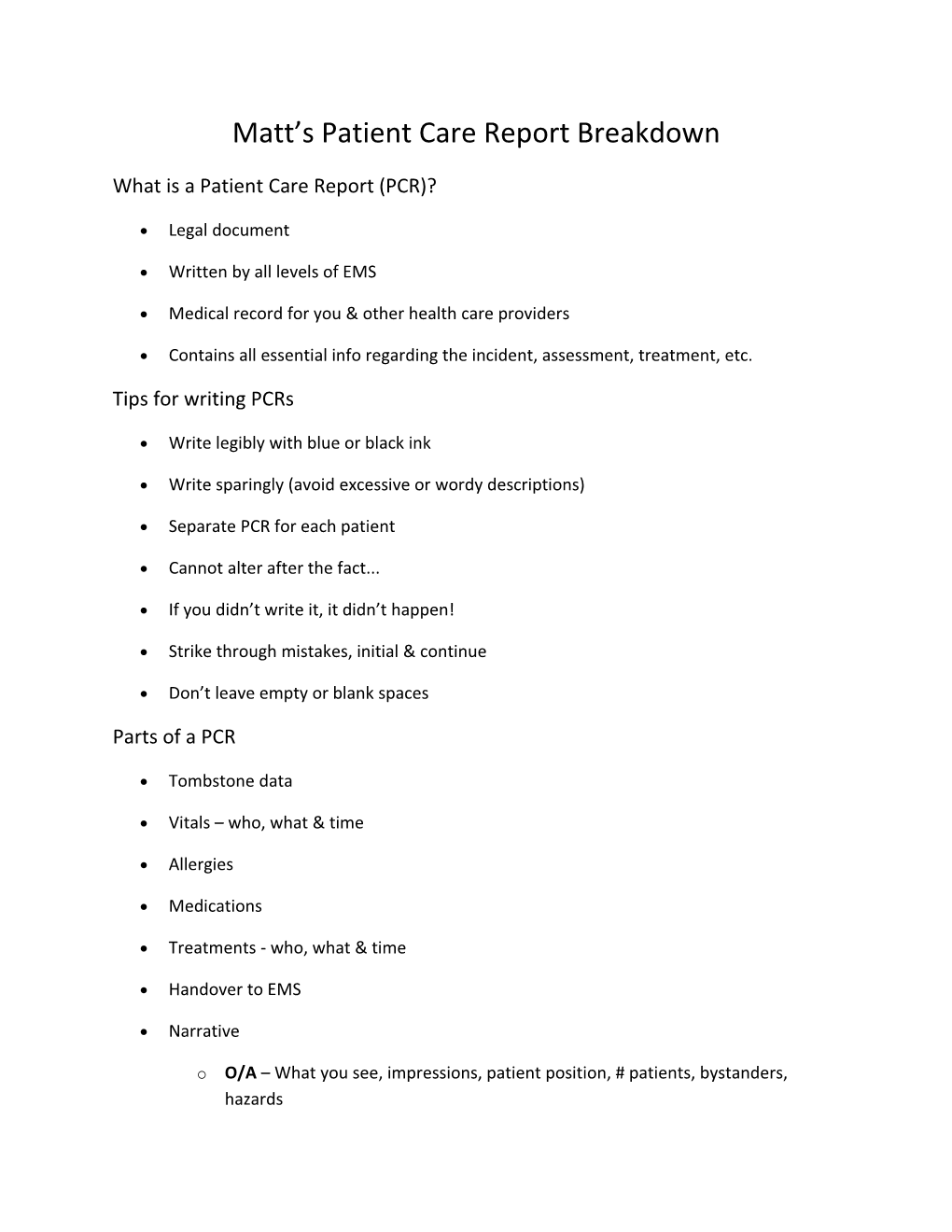Matt’s Patient Care Report Breakdown
What is a Patient Care Report (PCR)?
- Legal document
- Written by all levels of EMS
- Medical record for you & other health care providers
- Contains all essential info regarding the incident, assessment, treatment, etc.
Tips for writing PCRs
- Write legibly with blue or black ink
- Write sparingly (avoid excessive or wordy descriptions)
- Separate PCR for each patient
- Cannot alter after the fact...
- If you didn’t write it, it didn’t happen!
- Strike through mistakes, initial & continue
- Don’t leave empty or blank spaces
Parts of a PCR
- Tombstone data
- Vitals – who, what & time
- Allergies
- Medications
- Treatments - who, what & time
- Handover to EMS
- Narrative
- O/A – What you see, impressions, patient position, # patients, bystanders, hazards
- C/C – Patient’s own words, why called
- HxC/C – Onset, what patient was doing at time of onset, symptoms
- PmHx – Current or past pertinent medical conditions, smoking, substance abuse
- O/E – Findings of physical exam
- Tx – Interventions, management of patient
More Detail
O/A – Age, sex, position/location found, LOC (alert, taking, eyes tracking), scene observations, distress/dyspnea, calm/co-operative, first aid & by whom; home O2; family/bystanders present
MVC - # of vehicles, description, condition, location of patient in vehicle, # occupants, extrication required; obvious trauma, blood
C/C – What patient tells you, reason 911 called, related injuries
HxC/C – Events leading to emergency response, why/who called, pertinent statements from patient/family/bystanders, previous episodes, any loss of consciousness, how long?
Pain – OPQRST
MVC – Seatbelts, air bags, interior/exterior damage, starring on windshield, deformation of steering wheel, approximate speed, self-extrication
Vomit - # of times, blood?
Bowel movement - normal, when?
ETOH consumption - when, how much?
Drug use – amount, when?
Last meal, last urination
PERTINENT NEGATIVES
Pregnancy – LMP, sexually active, chance of being pregnant, gravida/para/abortus, gestation period
DNR? Personal directive?
Change in meds?
Last seen doctor/hospital – Tx & results
O/E – On Examination
CNS – A/O PPTE, GCS, AVPU, PEARL – size, fixed, pinpoint; drainage from ears/nose, Battle’s signs, Racoon eyes
CVS – Skin – colour/condition/temp, peripheral/central pulses present/absent & rate/rhythm/quality, BP, edema
HEENT – Pain, audio-disturbances, airway patent, swelling, facial droop, slurred speech, odour on breath, mucosa, cyanosis, JVD, tracheal deviation, trauma
CHEST – Air entry – clear apices to bases, adventitious sounds, bilateral chest rise, dyspnea – exertion/rest, cough – productive/non-productive, trauma, pain, accessory muscle use, barrel chest, indrawing, pacemaker, medication patches
ABD – Trauma, pain on palpitation – quadrant?, DRT – rebound, guarding, scars, pulsating masses, needle marks, nausea, vomit, bowel movements, urine output
PELVIS – Stable, trauma, pain, incontinence, priapism, bleeding, discharge
EXT’S – PMS x 4, strong/weak pulses, deficits, grip strength, pedal/peripheral edema, needle marks, cyanosis, trauma, pain
BACK – Trauma, pain, sacral edema
TX – Treatments
Following from patient assessment:
- O2 – admin device, flow rate
- BVM – ventilation rate (adjunct?)
- Spinal immobilization (collar, blocks, board, straps)
- CPR performed
- AED – number of times shocked
- Suctioning – device used, # of times
- Bandage/splinting – PMS present prior to & after
- Position on stretcher
- TPT normal/emergency
- Complications en route
- Or no Tx – why?
